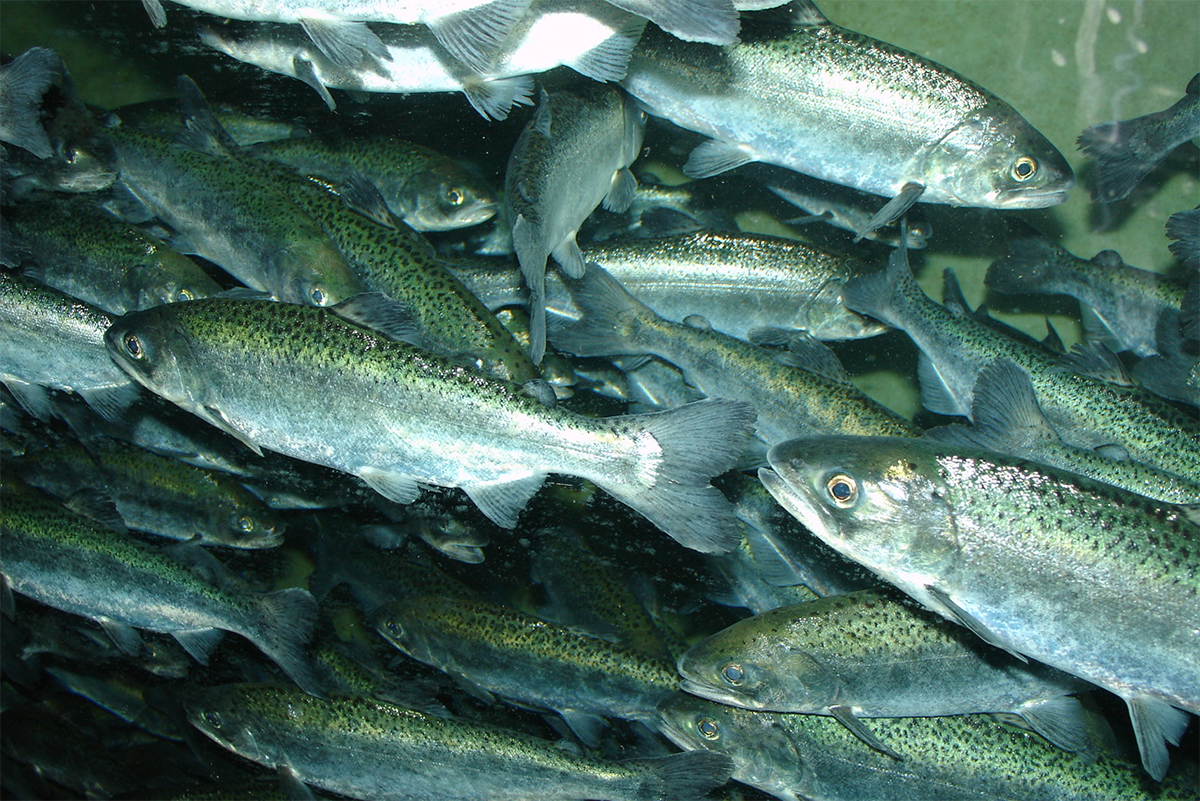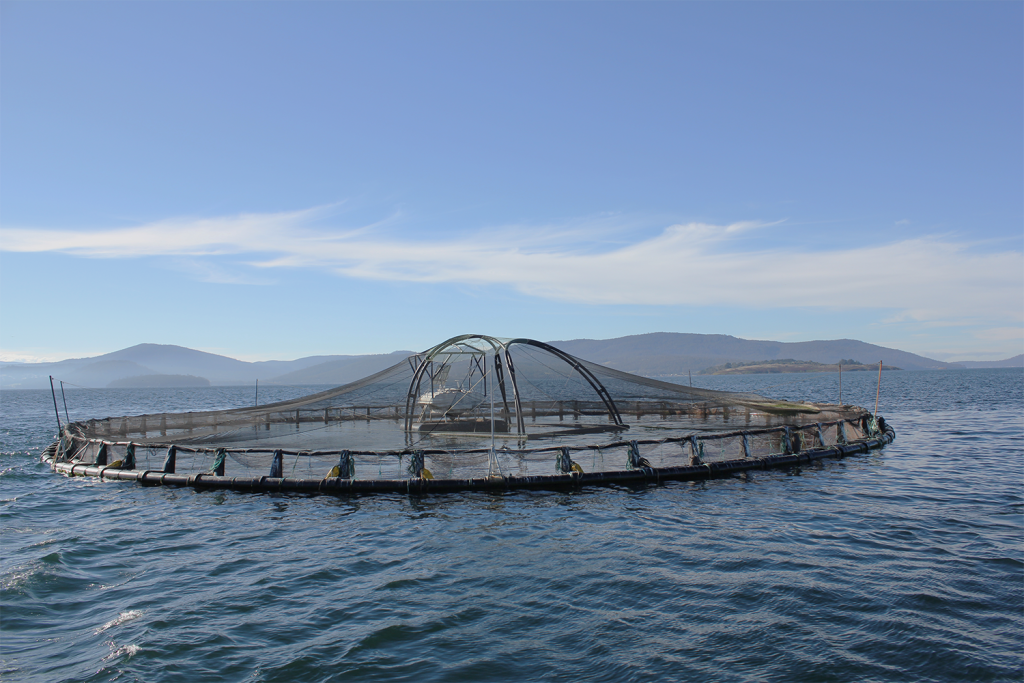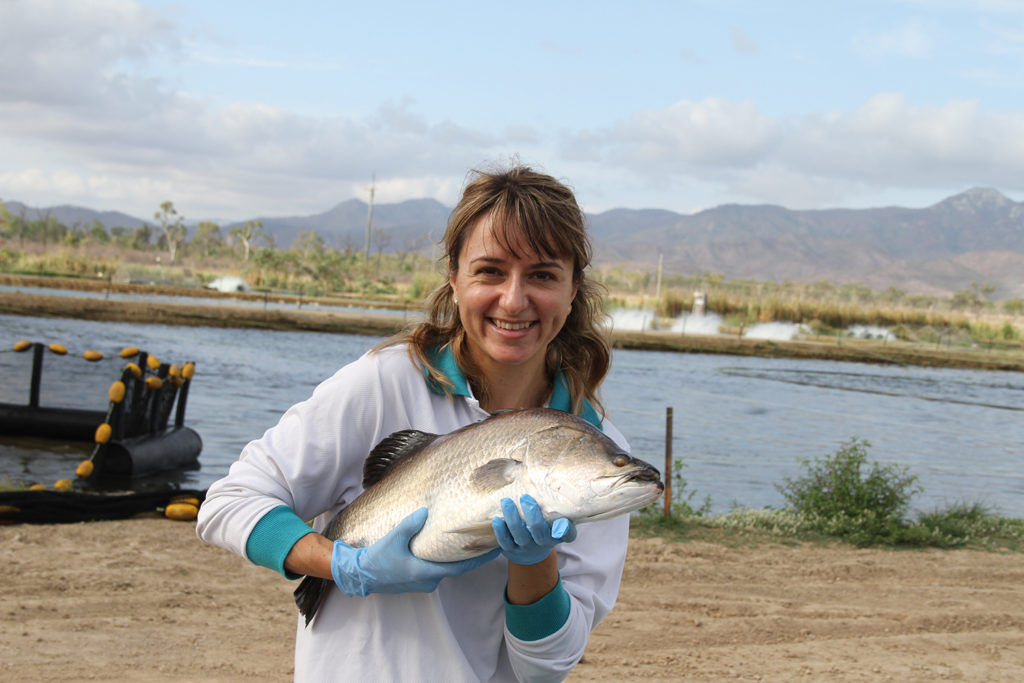eDNA sampling and analyses using qPCR and metabarcoding are useful tools for detecting Atlantic and Pacific salmon and threats to their health and habitats

Atlantic and Pacific salmon species are economically, culturally and ecologically important resources. Thus, the development and application of tools to inform the conservation and management of salmon promotes the continued realization of these diverse economic, cultural and ecological values.
The ongoing and rapid development and application of approaches to detect and quantify environmental DNA (eDNA) have the potential to help improve our understanding of the distribution, abundance and health of salmon species. Environmental DNA broadly refers to genetic material in the environment including that which is extra-organismal and present in unicellular organisms or viruses.
When applied to describing fish assemblages in aquatic environments, eDNA approaches generally involve the detection, measurement and/or sequencing of DNA shed by developing, mature, or dead fish into the water column. Similar approaches may be used to target DNA of biological organisms that may compromise fish health (e.g., viruses, bacteria and parasites). Analysis of eDNA has the potential to generate estimates of population presence/absence, relative abundance/biomass and genetic diversity with variable degrees of certainty and resolution.
This article – condensed from the original publication (Ramey, A.M. et al. 2023. Environmental DNA as a Tool for Better Understanding the Distribution, Abundance, And Health of Atlantic Salmon and Pacific Salmon. Fisheries Magazine 49(4): 169-180) – summarizes the published literature on the application of eDNA approaches for describing the distribution, abundance, and health of various species of Atlantic and Pacific salmon.
The authors conducted a systematic search for peer-reviewed research articles investigating the distribution, abundance, and health of Atlantic and Pacific salmon species using eDNA. For this review, we consider eDNA studies on Atlantic salmon (Salmo salar), Chinook salmon (Oncorhynchus tshawytscha), Chum salmon (O. keta), Coho salmon (O. kisutch), Masu salmon (O. masou), Sockeye salmon (O. nerka), and pink salmon (O. gorbuscha). We summarize information in the context of advances, opportunities, and challenges to help fishery managers determine suitable roles for eDNA analyses in their decision-making processes. For additional information, refer to the original publication.
Advancement: Detection of salmon
Given that salmon use distinct aquatic habitats at different life history stages, a large number of studies have been devoted to assessing the abundance, distribution, and residence time of salmonid DNA across diverse marine, estuarine, and freshwater systems. These environments are highly variable in water chemistry, temperature, currents, hydrology, and the life stages of salmon that they support; in turn, these factors have implications for the distribution and residence time of eDNA in the water column.
Multiple studies have demonstrated that qPCR-based eDNA (quantitative polymerase chain reaction, or qPCR, a method by which the amount of the PCR product can be determined in real-time) approaches may be used to detect salmon presence and qualitatively describe trends in abundance in nearshore marine environments. Taken together, these studies show that salmonid eDNA can be reliably detected in nearshore and estuarine environments that are tidally influenced and affected by complex hydrologic regimes.
In recent years, eDNA has emerged as a useful tool for evaluating habitat restoration efforts and monitoring salmon recolonization of riverine habitats. Various studies have provided evidence that the timing and spatial extent of recolonization differed by species and that eDNA approaches were complementary to traditional fisheries surveys that were limited in frequency and difficult to conduct in the upper portions of the watershed, which are located in backcountry wilderness.
Through various field experiments, eDNA from salmon has appeared to be conserved and readily detected over small spatial scales of 10–100 m when fish are present, though DNA from salmon also appears to degrade, settle, or otherwise become less detectable over larger distances of approximately 1 km or greater in lotic systems. This generality is consistent with estimates of eDNA transport distances derived from various studies.
Advancement: Estimating salmon abundance
Absolute measures of salmon abundance using eDNA approaches have not yet been achieved and may remain elusive due, in part, to the numerous factors that influence the detection and quantification of extra-organismal DNA. However, initial attempts to develop indices of salmon abundance indicate that eDNA approaches may supplement more traditional sampling methods for informing fisheries management.
For example, through the environmental sampling of estuarine environments and streams in the northwestern United States, positive correlations have been shown to exist between concentrations of salmon eDNA detected and the abundance of out-migrating Pacific salmon smolt as well as fish returning to spawn. Thus, there is evidence that qPCR approaches may serve as credible indices of salmon abundance when factors such as fish life stage, total salmon biomass, and fish density are accounted for.
Advancement: Monitoring salmon health and habitat
A variety of eDNA approaches have been used to detect pathogens and parasites in the water column demonstrating that eDNA can be a useful tool for identifying potential threats to salmon health. Various eDNA metabarcoding approaches have been used to monitor marine ecosystem health in response to salmon aquaculture.
Collectively, prior studies employing eDNA metabarcoding approaches provide evidence that these tools have value for monitoring ecosystem perturbations relative to salmon aquaculture facilities. Furthermore, metabarcoding approaches may be useful for monitoring the health of both farmed fish and the marine environments they inhabit.
Opportunity: Alternative tools for surveying and monitoring salmon and their habitat

Environmental DNA analysis represents a potentially highly sensitive and less invasive way to assess the occurrence and distribution of protected, low abundance fish stocks. Generally, concordant trends in eDNA data reported in these investigations, as compared to information derived from more traditional sampling approaches, highlighted the potential of environmental sampling and molecular analyses to serve as a minimally invasive supplemental or alternative approach to the capture and handling of fish.
In a complementary investigation, qPCR results from controlled experiments conducted in a hatchery setting using Coho salmon have exemplified how methods to estimate and report statistical rigor of inference for the detection of low abundance, high-priority salmon may be incorporated in study designs.
The application of eDNA approaches also offers promise for identifying rearing habitat occupied by salmon during early life stages when they may be difficult to observe or time-consuming to differentiate by species. Environmental DNA approaches for identifying stream habitat used by juvenile salmon may be most valuable for informing management when combined with other analytical approaches. For example, intrinsic potential habitat modeling and eDNA detection of Chinook Salmon were used to identify potential rearing habitat in the Chena River Basin, USA.
Opportunity: Detection of distribution changes for salmon, their pathogens, and invasive species
The application of eDNA approaches appears to hold promise for helping infer changes in species occupancy of habitat. The application of eDNA detection tools may also be helpful to understand species range expansions, for example, the colonization and establishment of salmon into new watersheds within the Arctic in response to climate change.
Application of qPCR eDNA detection approaches have already shown promise to serve as tools for understanding salmon as an invasive species, such as the establishment of Chinook and Coho salmon in the Patagonia region of Argentina and Chile, and Coho salmon on the Korean Peninsula. Similar eDNA approaches may be useful for monitoring rivers in the Pacific Northwest region of Canada and the USA for Atlantic salmon that may escape from aquaculture pens off the coast of British Columbia.
The application of eDNA tools also shows promise for the early detection of emergent pathogens or invasive species that could negatively impact fish health, with the potential to promote rapid response and effective mitigation and management strategies.
Opportunity: Near real-time approaches to inform management
The continued development and refinement of autonomous eDNA sampling and analytical tools offers the possibility of obtaining rigorous information on the occurrence of salmon and pathogens of salmon in near real-time to support fisheries management.
Quantitative eDNA detection approaches hold promise for estimating trends of in-river fish abundance given prior findings supporting positive correlations between Pacific salmon abundance and eDNA concentrations in Alaska, USA using qPCR. Continued refinement of such approaches, combined with integration into workflows employing autonomous eDNA sampling, offers the potential to supplement more traditional labor-intensive fish enumeration approaches (e.g., weirs, sonar, surveys, test fisheries, and electrofishing) in near real-time to support fisheries management. However, significant analytical, technological, and logistical challenges need to be overcome prior to the realization of this application.
In the fight against seafood fraud, the technology behind trace element fingerprinting is maturing
Challenge: Factors affecting eDNA detection and quantification
The detection and quantification of eDNA may be influenced by numerous factors related to the deposition of DNA into the environment, downstream transport and DNA degradation. The deposition of DNA from salmon into the environment is a function of the number and density of fish, total biomass, life stage of fish present and the relative proportion of live and dead fish, none of which can currently be assessed through the application of eDNA analytical techniques alone. Downstream transport is a function of substrate, stream velocity and volume, which influence dilution and settling of eDNA.
Accurately characterizing and quantifying streamflow and volume may be logistically challenging in some aquatic habitats, particularly in areas with large or highly irregular margins, as well as remote watersheds lacking stream gauges and strongly influenced by precipitation and/or extreme tidal fluctuations. Though recent advances in remote sensing approaches may facilitate approximations of stream discharge in many instances, estimates for ungauged streams are prone to high uncertainty and error.
Degradation of eDNA depends on many factors, including time since deposition into the environment, ambient temperature, pH, salinity, UV light penetration and microbial/enzymatic interactions. Data on the influence of these variables, and their interactions, on eDNA degradation in field settings are limited. Investigations of salmon eDNA may be made more effective by incorporating measures of physical and biological parameters in study systems as part of sampling strategies, and by accounting for them in analyses, to meet project objectives.
Challenge: Cost
Costs for development, testing and validation of eDNA tools may be considerable and, therefore, leveraging costs by applying previously established markers and analytical approaches may provide efficiencies depending on the project scope and sampling strategy. Specialized instruments and highly trained staff are required for analysis of eDNA samples, though sample collection efforts are typically less technical and may be executed by personnel with limited or no prior technical experience.
Autonomous eDNA samplers have recently been developed and applied towards the detection of salmon and other species. However, these devices are generally more expensive than manual sampling approaches and still require periodic site visits to obtain samples and replace consumables.
Such samplers might be made more accessible and efficient through further technological and engineering advances to increase sample capacity, to incorporate in situ analytics and to manufacture at a lower cost. As applications of eDNA techniques become more common, costs associated with technology may decline with scale. Furthermore, creative ways of leveraging sampling costs may be helpful in bringing the potential of eDNA tools for biomonitoring to fruition.
Perspectives
Given recent advances, eDNA sampling and analyses using both qPCR and metabarcoding now serve as useful tools for detecting Atlantic and Pacific salmon and understanding threats to the health of fish and their habitats. Opportunities exist to apply sensitive and minimally invasive eDNA approaches to detect fish and assess fish habitat, assess range expansions of salmon and salmon pathogens, and detect invasives that may threaten salmon health and abundance. The development of near real-time eDNA detection and quantification approaches to inform fisheries management may be on the horizon.
Challenges limiting the widespread application of eDNA approaches for informing salmon management include accounting for the many factors affecting detection and quantification of eDNA, limits of data for deriving inference, and expense. Through continued development and refinement, including additional validation utilizing concurrent data streams, both qPCR and metabarcoding approaches are anticipated to become increasingly utilized eDNA tools available to managers of Atlantic and Pacific salmon fisheries.
Now that you've reached the end of the article ...
… please consider supporting GSA’s mission to advance responsible seafood practices through education, advocacy and third-party assurances. The Advocate aims to document the evolution of responsible seafood practices and share the expansive knowledge of our vast network of contributors.
By becoming a Global Seafood Alliance member, you’re ensuring that all of the pre-competitive work we do through member benefits, resources and events can continue. Individual membership costs just $50 a year.
Not a GSA member? Join us.
Author
-
Andrew M. Ramey, Ph.D.
Corresponding author
U.S. Geological Survey Alaska Science Center, 4210 University Drive, Anchorage, AK, 99508 USA
Related Posts

Health & Welfare
Detection and quantification of sea lice using eDNA around aquaculture locations
Novel study uses fully automated L. salmonis eDNA quantification for autonomous water sample analysis of gene targets to monitor parasitic loads.

Health & Welfare
Predicting parasite outbreaks in fish farms through environmental DNA
This article presents the results of a study using environmental DNA methodology for the early detection and quantification of various pathogens in farmed barramundi, where the technique showed to be a powerful and novel tool to predict fish mortalities.

Aquafeeds
Soy helped build aquaculture into a global force. How far can it take it?
Soy has fueled the growth of aquaculture, but environmental and social concerns for some producing areas are prompting some fish farmers to take stock.

Intelligence
Can a ‘chemical fingerprint’ deter seafood fraud?
Because paper trails aren’t perfect, some food producers are going beyond written or digital records to prove their products’ authenticity and prevent economic fraud. Is farmed seafood a perfect fit for forensic-science traceability?



